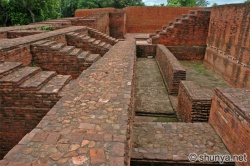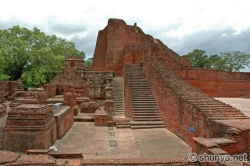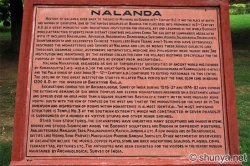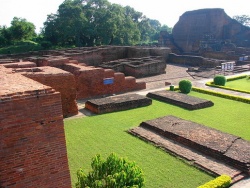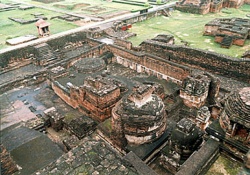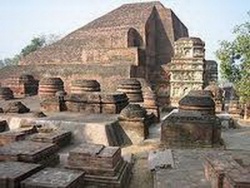Nalanda
Nālandā was an ancient center of higher learning in Bihar, India. The site is located about 88 kilometres south east of Patna, and was a religious center of learning from the fifth century CE to 1197 CE.Nalanda flourished between the reign of the Śakrāditya (whose identity is uncertain and who might have been either Kumara Gupta I or Kumara Gupta II) and 1197 CE, supported by patronage from the Hindu Gupta rulers as well as Buddhist emperors like Harsha and later emperors from the Pala Empire.
The complex was built with red bricks and its ruins occupy an area of 14 hectares. At its peak, the university attracted scholars and students from as far away as Tibet, China, Greece, and Persia. Nalanda was ransacked and destroyed by an army under Bakhtiyar Khilji in 1193. The great library of Nalanda University was so vast that it is reported to have burned for three months after the invaders set Fire to it, ransacked and destroyed the Monasteries, and drove the Monks from the site. In 2006, Singapore, China, India, Japan, and other nations, announced a proposed plan to restore and revive the ancient site as Nalanda International University.
Etymology
The Chinese pilgrim-Monk Xuanzang gives several explanations of the name Nālandā. One is that it was named after the Nāga who lived in a tank in the middle of the mango grove. Another, the one he accepted, is that Shakyamuni Buddha once had his capital here and gave "alms without intermission", hence the name.
Śāriputra died at the village called 'Nalaka,' which is also identified as Nalanda by many scholars.
History
Replica of the seal of Nalanda University set in terracotta on display in the ASI Museum in Nalanda
History of the university and the Gupta heyday
Some historical studies suggest that the University of Nalanda was established during the reign of a king called Śakrāditya, of the Gupta Dynasty.Both Xuanzang and Prajñavarman cite him as the founder, as does a seal discovered at the site.
As historian Sukumar Dutt describes it, the history of Nalanda university "falls into two main divisions—first, one of growth, development and fruition from the sixth century to the ninth, when it was dominated by the liberal cultural traditions inherited from the Gupta age; the second, one of gradual decline and final dissolution from the ninth century to the thirteen—a period when the tantric developments of Buddhism became most pronounced in eastern India."
Nalanda in the Pāla era
A number of Monasteries grew up during the Pāla period in ancient Bengal and Magadha. According to Tibetan sources, five great Mahaviharas stood out: Vikramashila, the premier university of the era; Nalanda, past its prime but still illustrious, Somapura, Odantapurā, and Jaggadala. The five Monasteries formed a network; "all of them were under state supervision" and there existed "a system of co-ordination among them . . it seems from the evidence that the different seats of Buddhist learning that functioned in eastern India under the Pāla were regarded together as forming a network, an interlinked group of institutions," and it was common for great scholars to move easily from position to position among them.
During the Pālā period, the Nālānda was less singularly outstanding, as other Pāla establishments "must have drawn away a number of learned Monks from Nālānda when all of them . . came under the aegis of the Pālās."
Decline and end
Evidence in literature suggests that in 1193, the Nalanda University was sacked by the fanatic Bakhtiyar Khilji, a Turk. Muslim conquest in India is seen by scholars as one of the reasons of the decline of Buddhism in India. The Persian historian Minhaj-i-Siraj, in his chronicle the Tabaqat-I-Nasiri, reported that thousands of Monks were burned alive and thousands beheaded as Khilji tried his best to uproot Buddhismthe burning of the library continued for several months and "smoke from the burning manuscripts hung for days like a dark pall over the low hills."
The last throne-holder of Nalanda, Shakyashribhadra, fled to Tibet in 1204 CE at the invitation of the Tibetan translator Tropu Lotsawa (Khro-phu Lo-tsa-ba Byams-pa dpal). In Tibet, he started an ordination lineage of the Mulasarvastivadin lineage to complement the two existing ones.
When the Tibetan translator Chag Lotsawa (Chag Lo-tsa-ba, 1197–1264) visited the site in 1235, he found it damaged and looted, with a 90-year-old teacher, Rahula Shribhadra, instructing a class of about 70 students. During Chag Lotsawa's time there an incursion by Turkish soldiers caused the remaining students to flee. Despite all this, "remnants of the debilitated Buddhist community continued to struggle on under scarce resources until c. 1400 CE when Chagalaraja was reportedly the last king to have patronized Nalanda."
Ahir considers the destruction of the temples, Monasteries, centres of learning at Nalanda and northern India to be responsible for the demise of ancient Indian scientific Thought in mathematics, astronomy, alchemy, and anatomy.
Overview
Pilgrimage to
Buddha's
Holy Sites
Dharma Wheel.svg
The Four Main Sites
Lumbini · Bodh Gaya
Sarnath · Kushinagar
Four Additional Sites
Sravasti · Rajgir
Sankissa · Vaishali
Other Sites
Pataliputra · Gaya · Kosambi
Kapilavastu · Devadaha
Kesariya · Pava
Nalanda · Varanasi
Later Sites
Sanchi · Mathura
Ellora · Ajanta · Vikramshila
Ratnagiri · Udayagiri · Lalitgiri
Bharhut · Barabar Caves
view
talk
edit
Nalanda was one of the World's first residential universities, i.e., it had dormitories for students. It is also one of the most famous universities. In its heyday, it accommodated over 10,000 students and 2,000 teachers. The university was considered an architectural masterpiece, and was marked by a lofty wall and one gate. Nalanda had eight separate compounds and ten temples, along with many other Meditation halls and classrooms. On the grounds were lakes and parks. The library was located in a nine storied building where meticulous copies of texts were produced. The subjects taught at Nalanda University covered every field of learning, and it attracted pupils and scholars from Korea, Japan, China, Tibet, Indonesia, Persia and Turkey. During the period of Harsha, the Monastery is reported to have owned 200 villages given as grants.
The Tang Dynasty Chinese pilgrim Xuanzang left detailed accounts of the university in the 7th century. He described how the regularly laid-out towers, forest of pavilions, harmikas and temples seemed to "soar above the mists in the sky" so that from their cells the Monks "might witness the birth of the winds and clouds." The pilgrim states: "An azure pool winds around the Monasteries, adorned with the full-blown cups of the blue Lotus; the dazzling red Flowers of the lovely kanaka hang here and there, and outside groves of mango trees offer the inhabitants their dense and protective shade."
The entrance of many of the viharas in the Nalanda University ruins can be seen with a bow marked floor; the bow was the royal sign of the Guptas.
Libraries
Structure The library at Nalanda University was an immense complex. Called the Dharmaganja, or Piety Mart, it was separated into three large buildings: the Ratnasagara, the Ratnadadhi, and the Ratnaranjaka. The Ratnadadhi, meaning the Ocean of Gems, was nine stories high and housed the most sacred manuscripts including the Prajnaparamita Sutra and the Samajguhya.The towers were supposedly immense, bejewelled and gilded to reflect the rays of the sun. According to the Bhaskara Samhita, an ancient text on organizational practices, the library was to be built in a “finely built stone building” and each manuscript would have been placed on iron shelves or stack and covered with cloth and tied up. Furthermore, the librarian in charge, according to the text, was not only responsible for maintaining the materials but also for guiding readers in their studies The exact number of volumes of the Nulanda University Library is not known but it is estimated to have been in the hundreds of thousands. The library not only collected religious manuscripts but also had texts on such subjects as grammar, logic, literature, Astrology, astronomy, and medicine
Classification It is clear that Nalanda University library had a classification scheme which was possibly based on a text classification scheme developed by the great Sanskrit linguist Panini.Buddhists texts were most likely divided in three classes based on the Tripitaka’s three main divisions: the Vinaya, Sutra, and the Abhidamma. Like most other Indian ancient and medieval period libraries, Nalanda would have used a basic catalogue to help patrons find materials. This bibliography, or Anukamanikas, would have listed the Books by hymns, authors, Form of sutras, Rishi’s name, and the hymnal metre.
Destruction The library was destroyed in 1197–1203 during the Muslim invasion in which Bakhtiyar Khalji sacked it and set it to flames. According to Tibetan legend, the university and library were reportedly repaired shortly after by Muditabhadra, a Buddhist sage. Unfortunately, the library was again burned by Tirthaka medicants.
Curriculum
In nalanda university,the Tibetan tradition holds that there were "four doxographies" (Tibetan: grub-mtha’) which were taught at Nālandā, and Alexander Berzin specifies these as:
Sarvāstivāda Vaibhāṣika
Sarvāstivāda Sautrāntika
Mādhyamaka, the Mahāyāna philosophy of Nāgārjuna
Cittamatra, the Mahāyāna philosophy of Asaṅga and Vasubandhu
According to an unattributed article of the Dharma Fellowship (2005), the curriculum of Nalanda University at the time of Mañjuśrīmitra contained:
...virtually the entire range of World Knowledge then available. Courses were drawn from every field of learning, Buddhist and Hindu, sacred and secular, foreign and native. Students studied science, astronomy, medicine, and logic as diligently as they applied themselves to metaphysics, philosophy, Samkhya, Yoga-shastra, the Veda, and the scriptures of Buddhism. They studied foreign philosophy likewise.
In the 7th century, Xuanzang records the number of teachers at Nālandā as being around 1510. Of these, approximately 1000 were able to explain 20 collections of sūtras and śāstras, 500 were able to explain 30 collections, and only 10 teachers were able to explain 50 collections. Xuanzang was among the few who were able to explain 50 collections or more. At this time, only the abbot Śīlabhadra had studied all the major collections of sūtras and śāstras at Nālandā.
Yijing wrote that matters of discussion and administration at Nālandā would require assembly and consensus on decisions by all those at the assembly, as well as resident Monks:
If the Monks had some business, they would assemble to discuss the matter. Then they ordered the officer, Vihārapāla, to circulate and report the matter to the resident Monks one by one with folded hands. With the objection of a single Monk, it would not pass. There was no use of beating or thumping to announce his case. In case a Monk did something without consent of all the residents, he would be forced to leave the Monastery. If there was a difference of opinion on a certain issue, they would give reason to convince (the other group). No force or coercion was used to convince.
Xuanzang also writes: "The lives of all these virtuous men were naturally governed by habits of the most solemn and strictest kind. Thus in the seven hundred years of the Monastery's existence no man has ever contravened the rules of the discipline. The king showers it with the signs of his respect and veneration and has assigned the revenue from a hundred cities to pay for the maintenance of the religious."
Influence on Buddhism
A vast amount of what came to comprise Tibetan Buddhism, both its Mahayana and Vajrayana traditions, stems from the late (9th–12th century) Nalanda teachers and traditions. The scholar Dharmakirti (ca. 7th century), one of the Buddhist founders of Indian philosophical logic, as well as and one of the primary theorists of Buddhist atomism, taught at Nalanda.
Other forms of Buddhism, such as the Mahāyāna Buddhism followed in Vietnam, China, Korea and Japan, flourished within the walls of the ancient university. A number of scholars have associated some Mahāyāna texts such as the Śūraṅgama Sūtra, an important Sūtra in East Asian Buddhism, with the Buddhist tradition at Nālandā. Ron Epstein also notes that the general doctrinal position of the Sūtra does indeed correspond to what is known about the Buddhist teachings at Nālandā toward the end of the Gupta period when it was translated.
According to Hwui-Li, a Chinese visitor, Nālandā was held in contempt by some Sthaviras for its emphasis on Mahayana philosophy. They reportedly chided King Harṣa for patronising Nalanda during one of his visits to Odisha, mocking the "sky-flower" philosophy taught there and suggesting that he might as well patronise a Kapalika temple. When this occurred, Harṣa notified the chancellor of Nālandā, who sent the Monks Sāgaramati, Prajñāraśmi, Siṃharaśmi, and Xuanzang to refute the views of the Monks from Odisha.
Excavations
Excavations conducted by Archaeological Survey of India during 1915–37 and 1974–82 have exposed the extensive remains of six major brick temples and eleven Monasteries arranged on a systematic layout and spread over an area of more than a square kilometre. Basically a hundred feet wide passage runs north-south with the row of temples on the west and that of the Monasteries on the east of it.
The Monasteries are quite identical in general layout and appearance. Central courtyard, row of cells all around with a common verandah, a secret chamber for keeping valuables, staircase for going to upper stories, kitchen, well, granary, single entrance and common place for prayer or meeting etc. are some characteristic features of almost all the Monasteries at Nalanda. The main temple site 3 is the largest and most imposing structure at southern extremity of the row of temples and is surrounded by votive stupas. Originally it had four corner towers out of which two are in existence and decorated with rows of niches containing beautiful stucco images of Buddha and Bodhisattvas which are fine specimens of Gupta Art. A temple different in character and not conforming to the general layout of the remains is represented by temple site 2. The interesting feature of this temple is the dado of two hundred and eleven sculptured panels over the moulded plinth. Another mound called 'Sarai Tila' very close to the Monastery complex has revealed ruins of a temple with murals and feet portion of a colossal stucco image of Lord Buddha.
Other than structures, the excavations have unearthed many sculptures and images in stone, bronze and stucco. Significant among the Buddhist sculptures are Buddha in different postures, Avalokitesvara, Manjusri, Tara, Prajnaparamita, Marichi, Jambhala etc. and a few images are of Brahmanical deities like Vishnu, Siva-Parvati, Mahishasura-mardini, Ganesa, Surya etc. Other noteworthy discoveries of excavations include the murals, copper plates, inscriptions, sealings, plaques, coins, terracottas, potteries etc. The antiquities have been exhibited for the visitors in the site museum maintained by the Archaeological Survey of India.
Ruins
A number of ruined structures survive. Nearby is the Surya Mandir, a Hindu temple. The known and excavated ruins extend over an area of about 150,000 square metres, although if Xuanzang's account of Nalanda's extent is correlated with present excavations, almost 90% of it remains unexcavated. Nālandā is no longer inhabited. Today the nearest habitation is a village called Bargaon.
In 1951, a modern centre for Pali (Theravadin) Buddhist studies was founded nearby by Bhikshu Jagdish Kashyap, the Nava Nalanda Mahavihara. Presently, this institute is pursuing an ambitious program of satellite imaging of the entire region.
The Nalanda Museum contains a number of manuscripts, and shows many examples of the items that have been excavated. India's first Multimedia Museum was opened on 26 January 2008, which recreates the history of Nalanda using a 3D animation film narrated by Shekhar Suman. Besides this there are four more sections in the Multimedia Museum: Geographical Perspective, Historical Perspective, Hall of Nalanda and Revival of Nalanda.
Plans for revival
On 9 December 2006, the New York Times detailed a plan in the works to spend $1 billion to revive Nalanda University near the ancient site. A consortium led by Singapore and including China, India, Japan and other nations will attempt to raise $500 million to build a new university and another $500 million to develop necessary infrastructure.
On 28 May 2007, Merinews reported that the revived university's enrolment will be 1,137 in its first year, and 4,530 by the fifth. In the 'second phase', enrolment will reach 5,812.
On 12 June 2007, News Post India reported that the Japanese diplomat Noro Motoyasu said that "Japan will fund the setting up an international university in Nalanda in Bihar". The report goes on to say that "The proposed university will be fully residential, like the ancient seat of learning at Nalanda. In the first phase of the project, seven schools with 46 foreign faculty members and over 400 Indian academics would come up." ... "The university will impart courses in science, philosophy and spiritualism along with other subjects. A renowned international scholar will be its chancellor."
On 15 August 2007, The Times of India reported that Dr A.P.J. Abdul Kalam has accepted the offer to join the revived Nalanda International University sometime in September 2007."
NDTV reported on 5 May 2008 that, according to Nobel Laureate Amartya Sen, the foundation of University would likely be in the year 2009 and the first teaching class could begin in a few years from then. Sen, who heads the Nalanda Mentor Group, said the final report in this regard, is expected to be presented to the East Asia Summit in December 2008.
On 11 May 2008, The Times of India reported that host nation India and a consortium of East Asian countries met in New York to further discuss Nalanda plans. It was decided that Nalanda would largely be a post-graduate research university, with the following schools: School of Buddhist studies, philosophy, and comparative Religion; School of historical studies; School of International Relations and Peace; School of Business Management and Development; School of Languages and Literature; and, School of Ecology and Environmental Studies. The objective of the school was claimed to be "aimed at advancing the concept of an Asian community...and rediscovering old relationships."
On 13 September 2010, the Jakarta Globe Reported Parliament in New Delhi passed a bill approving plans to rebuild the campus as a Symbol of India's global ambitions.
